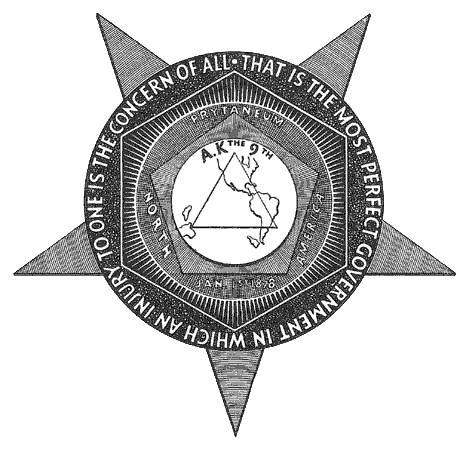Noble Order of the Knights of Labor: Difference between revisions
(Created.) Tag: Visual edit |
mNo edit summary Tag: Visual edit |
||
| Line 1: | Line 1: | ||
{{Infobox political party|name=Noble Order of the Knights of Labor|logo=Knights of Labor.png|founded=December 1869|founder=[[Uriah S. Stephens]]|slogan=}} | {{Infobox political party|name=Noble Order of the Knights of Labor|logo=Knights of Labor.png|founded=December 1869|founder=[[Uriah S. Stephens]]|membership_year=1889|membership=~700,000|political_line=[[Socialism]]|slogan=}} | ||
The '''Knights of Labor''', officially the '''Noble Order of the Knights of Labor''', was a labor organization in the [[United States of America|United States]]. | The '''Knights of Labor''', officially the '''Noble Order of the Knights of Labor''', was a labor organization in the [[United States of America|United States]]. | ||
Revision as of 07:30, 10 July 2022
Noble Order of the Knights of Labor | |
|---|---|
 | |
| Founder | Uriah S. Stephens |
| Founded | December 1869 |
| Membership (1889) | ~700,000 |
The Knights of Labor, officially the Noble Order of the Knights of Labor, was a labor organization in the United States.
History
The Knights of Labor was founded by Uriah S. Stephens in Philadelphia in 1869. It originally contained only garment workers but expanded to other trades in 1871. In 1878, it held its first national convention in Reading, Pennsylvania. In 1879, Stephens was succeeded by T.V. Powderley as leader.
The Knights of Labor participated in a general strike in 1886 for the eight-hour work day.
T.V. Powderley was replaced by J. R. Sovereign as leader of the Knights of Labor in 1893.[1]
Membership
The Knights of Labor had 52,000 members in 1883, 111,000 in 1885, and 700,000 in 1886. 10% of its members were women and there were many Black members. Petty bourgeois were allowed in the organization as long as they did not exceed 25% of local membership.[1]
Program
The Knights of Labor proposed a program that included labor and land reforms and nationalization of banks, railroads, and telegraphs.[1]
References
- ↑ 1.0 1.1 1.2 William Z. Foster (1952). History of the Communist Party of the United States: 'The Socialist Labor Party (1876-1890); The Knights of Labor'.